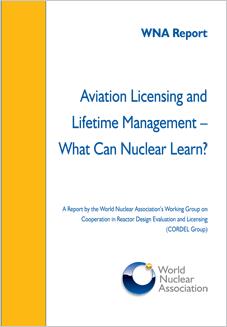Aviation Licensing and Lifetime Management – What Can Nuclear Learn?
This report, written by the Design Change Management Task Force of the World Nuclear Association’s (WNA’s) Cooperation in Reactor Design Evaluation and Licensing (CORDEL) Working Group, explores design licensing and design change management procedures in the civil aviation industry.
Both the nuclear and aviation industries operate within global and highly regulated regimes, and share an overall goal of excellence in safety and reliability. In the civil aviation industry, safety has been greatly enhanced in the last decades, as indicated by a significant decrease in the fatal accident rate.1 A major contributor to this has been international standardization and harmonization of the design approval and change management procedures. It is therefore likely that a review of the regulatory processes of the aviation industry will be of benefit to the nuclear industry.
Licensing of aircraft designs is based on a set of binding international minimum standards defined in Annex 8 of the 1944 Chicago Convention, supplemented by national airworthiness regulations. A type certificate is issued by the state of origin for the aircraft design. Type certificates are also issued separately by each state where that particular design of aircraft is registered. In addition, each aircraft is issued with an airworthiness certificate in the state in which the aircraft is registered.
Throughout the life of an aircraft design, the original designer is always involved in the response to events and safety-relevant findings. For serious events, the aviation authority of the state of design may issue an airworthiness directive, which will be based on solutions proposed by the original designer. This airworthiness directive requires other national authorities to implement remedial measures to their regulated entities, making sure that changes are applied consistently over the entire fleet of aircraft of the same design.
Several lessons can be learned from this industry’s system of regulation, including:
- Achievement of a UN-backed political agreement on the acceptance of basic safety requirements (Chicago Convention Annex 8).
- The design licensing (type certificate) process and bi- and multilateral acceptance agreements.
- Design change management and maintenance of type certificate throughout the lifetime of an
- aircraft design.
- Execution of the design authority role by manufacturers.
- Maintenance of the responsibility of national regulators within an internationally agreed framework.
